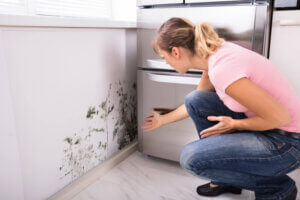How to Clean Moisture Stains in The Kitchen

There are a wide variety of tricks that allow you to clean moisture stains in the kitchen. No matter what material it’s made of, it’s one of the areas of the home most affected by this problem.
So, it’s common to notice mold on tiles, walls, ceilings, and furniture. What can you do about it? Keep reading.
Why moisture stains occur in the kitchen and how to clean them
The problem of moisture in the kitchen is caused by a phenomenon known as condensation. In condensation, the gaseous state of water changes to a liquid state. Within the home, this situation occurs most frequently in the bathroom and kitchen, as these are areas exposed to sudden changes in temperature.
The steam generated by the pots and pans when a meal is being prepared mixes with the cold ambient air, especially in winter. Over time, dark stains (mold) form on the walls, ceiling, or furniture.
Learn how to clean moisture stains in the kitchen

If you find that there are moisture stains in the kitchen or, even worse, mold and mildew have started to form, it’s time to get to work. To begin with, one of the most important aspects is to have good ventilation. An environment in which air circulates and is renewed reduces the effects of condensation.
In this regard, it’s important to activate the extractor fan or hood whenever cooking in order to remove the hot air from the steam. However, there are situations where this isn’t enough, and the following measures should be taken
Removing mold and mildew
If you noticed a deterioration in the wooden furniture decorating the kitchen, as well as bad smell or stains, it’s very likely that they’re affected by mold. To remove it, the following steps should be followed.
- Gloves and protection. Bleach will be used for this cleaning, which is very harmful to the skin. Therefore, it’s essential to wear latex or synthetic rubber gloves.
- Prepare the mixture. Fill a sprayer with a quarter of bleach and three quarts of water.
- Take care of the areas where the mildew is visible. Leave to act for 20 minutes.
- Remove the remains with a cloth or sponge.
- In case you haven’t removed everything, repeat the process.
How to clean the grout?
Another area of the kitchen that’s often affected by moisture, grease, and dirt in general is the grout. This is the material made up of plaster and cement that binds the tiles together. With frequent moisture, it tends to become yellowish and dirty.
So, how do you clean grout? This is a slightly more difficult area. There are several products on the market right now to protect this material. However, it’s possible to try cleaning with vinegar, water, and lemon juice. Optionally, you can use a little bleach diluted in water.
How to clean moisture stains in the kitchen and the sink

The sink often accumulates traces of organic matter that favor the creation of mold and the proliferation of bad smells. It’s important to avoid most of this debris by washing dishes thoroughly and throwing solids in the garbage. Moisture in the sink can be the result of a leak or condensation inside the pipe.
It’s a good idea to remove and clean the grates frequently. While, for the pipes, you can use vinegar, a little bleach, or a product specifically designed for the sanitization of pipes.
Taking care of the tiles
For the tiles, simply wipe with a sponge with soap and water, although white vinegar or baking soda can also be applied. It’s important to remove dust from the top down to avoid re-soiling what has already been cleaned
How to clean moisture stains in the kitchen and on the walls
Moisture in the kitchen can show up on almost any surface, including walls. With the tips provided, it can be removed and prevented from recurring.
However, the walls need a product to clean the mold and then a fungicide. If the stains return quickly, there’s likely to be an internal leak, so it’s best to have a specialist take a look at it.